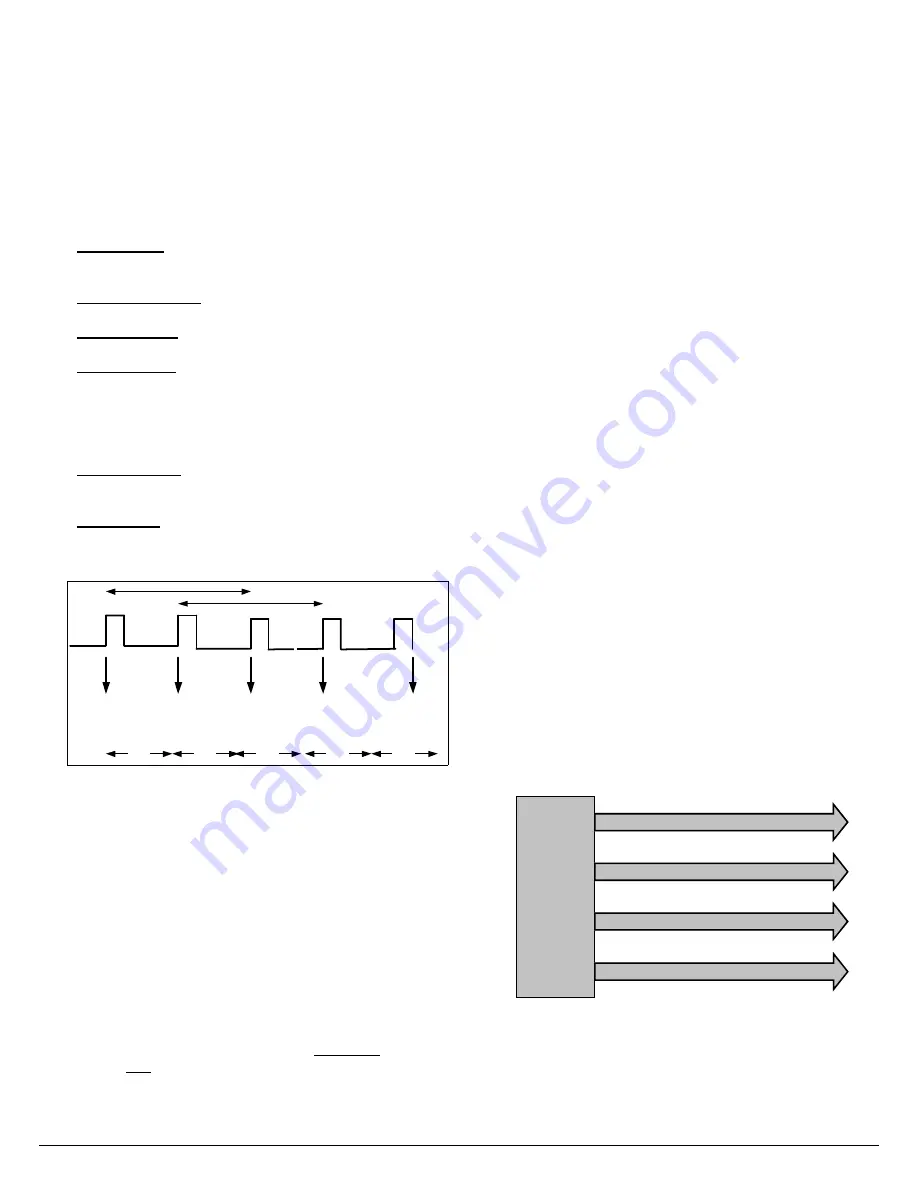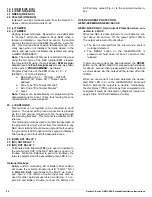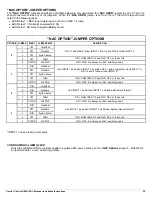
10 Gemini C-Series GEMC-NAC Extender Installation Instructions
NAC SYNCHRONIZATION RULES
The UL 864 9
th
edition standard includes the requirement
that
all visible notification appliances in the same field of
view and all audible notification appliances in the same
notification zone
operate in a synchronized manner.
The Gemini C-Series control panels and NAC extenders
comply with this standard with three different methods
that must be understood before a final installation
method is selected.
DEFINITIONS
1. NAC Circuit
: One of 4 possible outputs on either the
GEMC-NACXX or GEMC-XXXMB. Each NAC circuit
can deliver UP TO 2.0A.
2. Notification Zone
: A common evacuation area. Multi-
ple circuits can be in a zone.
3. Field of View:
All the strobes that can be seen by an
individual at any point WITHIN the protected premises.
4. Sync Pattern:
The GEMC-NACXX or GEMC-XXXMB
have two sync patterns: S1 and S2. A synchronized
NAC output must be assigned to S1 or S2. The two
sync patterns are ½ second apart as shown in Fig 1
below. S2 is referred to as the "offset" since it is offset
½ second from S1.
5. Synch Group:
A collection of NAC circuits on the
GEMC-XXXMB and one or multiple GEMC-NACXX's
sharing the same sync pattern.
6. Sync Input:
An input connection that allows a GEMC-
NACXX to synchronize its sync patterns to the main
panel or to another GEMC-NACXX.
Method 1 (Standard Temporal)
Most installations only require synchronized strobes and
synchronized temporal sounding appliances. The easi-
est method used to comply with this requirement is to
use either the compatible Wheelock or System Sensor
"Smart" devices, as listed in the GEMC-XXXMB installa-
tion instructions (WI1653). When these are used, the
strobes and horns can share the same NAC wires, re-
ducing the number, length and complexity of wire runs.
The following rules apply:
Rule 1:
"Smart" devices must either be System Sensor
or Wheelock, but both can not be used in the same sys-
tem.
Rule 2:
The total current from the combined NAC cir-
cuits on one GEMC-XXXMB or NAC7L/7S sharing the
same sync pattern cannot exceed 4A. [Example: NAC A
and B synched to S1 draw 4A and NAC C and D are off-
set using S2 for a total of 2.5A].
Rule 3:
All notification appliances in the same field of
view must use the same sync pattern.
The maximum current draw from "Smart" (Synchronized)
circuits on either the GEMC-XXXMB or GEMC-NACXX
can not exceed 4A (non-synchronized NAC circuits can
draw a maximum 6.5A from the NAC's) if all visible notifi-
cation appliances are in the same field of view and all
audible notification appliances are in the same notifica-
tion zone.
However, if there are two or more Synch Groups, then
the full 6.5A maximum alarm current can be utilized by
wiring one group to the first two NAC's, wiring the second
group to the third and fourth NAC's and programming/
configuring the GEMC-XXXMB / GEMC-NACXX for
"NAC offset". This will cause the 2 pairs of NAC circuits
to activate the strobes and horns ½ a second apart.
Note:
Each NAC maximum current is 2A.
Warning:
Strobes not within the same sync group may never be
within the same field of view.
Rule 4:
If a group of notification appliances in the same
field of view and all audible notification appliances in the
same notification zone require more than 4A, an addi-
tional GEMC-NACXX must be used and synchronized
using a dedicated NAC circuit from a master GEMC-
XXXMB or GEMC-NACXX wired to the INPUT 1 of the
slave GEMC-NACXX.
Rule 5:
In large systems with multiple groups of notifica-
tion appliances in the same field of view and all audible
notification appliances in the same notification zone, the
maximum alarm current of each GEMC-XXXMB / GEMC-
NACXX can be utilized by programming / configuring the
GEMC-XXXMB / GEMC-NACXX for "NAC offset" and
grouping all non-offset outputs together and offset out-
puts together.
Small System – No NAC7L/7S Extender – Long Wire
Runs
In this example, NAC A, B, C and D are one Sync Group
using S1 supplying 4A on four circuits, with each circuit
supplying 1A. This allows the longest wire runs but
trades off against output power by limiting to 4A.
Small System – No NAC7L/7S Extender – Normal Runs
In this example, NAC A and B are one Sync Group using
S1 supplying 4A and NAC C and D are a Sync Group
using S2, offset from S1, supplying 2.5A:
v
Pattern
S1
Fires
Pattern
S2
Fires
Pattern
S1
Fires
Pattern
S2
Fires
0.5 Sec
Pattern
S1
Fires
0.5 Sec
0.5 Sec
0.5 Sec
0.5 Sec
FIG. 1: TWO SYNC PATTERNS ARE ½ SECOND APART
GEMC-
XXXMB
NAC A - Sync S1 - 1 Amp
NAC B - Sync S1 - 1 Amp
NAC C - Sync S1 - 1 Amp
NAC D - Sync S1 - 1 Amp











































